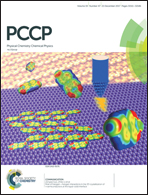Dynamics of poly(vinyl butyral) studied using dielectric spectroscopy and 1H NMR relaxometry†
Abstract
Dielectric Spectroscopy (DS) and 1H Fast Field-Cycling (FFC) NMR relaxometry were applied for understanding the dynamic behavior of the amorphous ter-polymer poly(vinyl butyral) (PVB) across the glass transition temperature (Tg = 70 °C by Differential Scanning Calorimetry). Above Tg, main chain segmental motions (α relaxation) were detected and characterized using both DS and FFC NMR relaxometry. The correlation times extracted by the analysis of DS and FFC NMR relaxometry data agreed within a factor of three and showed a Vogel–Fulcher–Tammann temperature dependence, with an associated Tg of 69 °C and a fragility of 155 for PVB glass. Below Tg, a secondary process (β relaxation) was revealed by DS, and was ascribed to reorientations of the vinyl alcohol dipoles due to local twisting motions with an associated activation barrier of 11 kcal mol−1. The β process was also found to contribute to 1H NMR relaxation above Tg.



 Please wait while we load your content...
Please wait while we load your content...